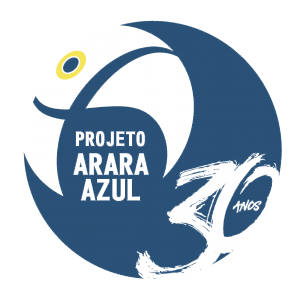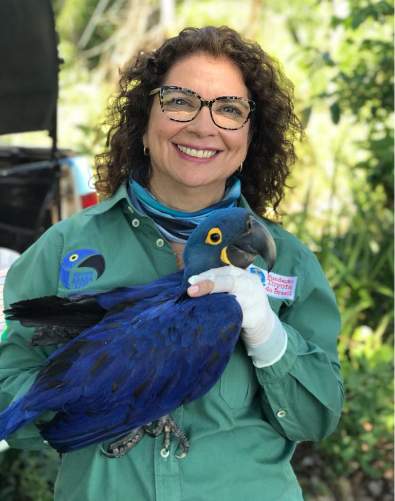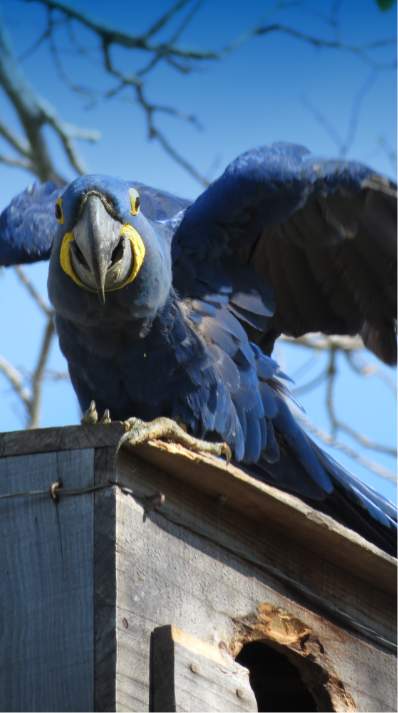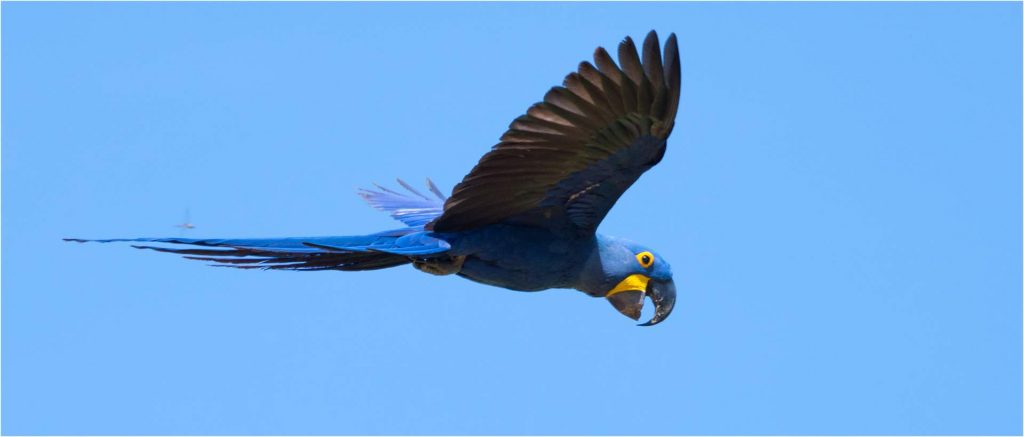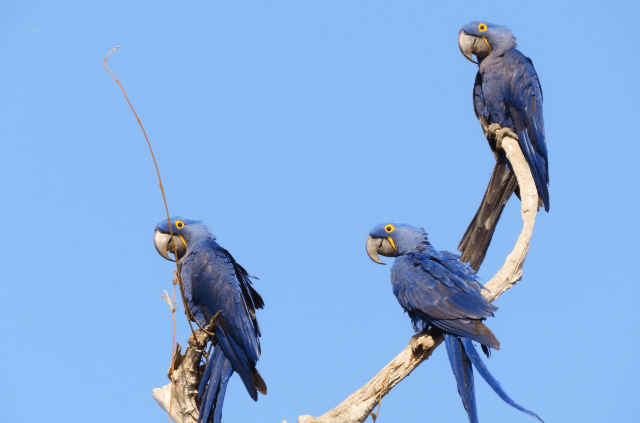The Hyacinth Macaw Project (Projeto Arara Azul) studies the biology and ecological relationships of the hyacinth macaw and manages and promotes the conservation of the hyacinth macaw in its natural habitat. The project studies the reproductive biology of scarlet macaws, toucans, hawks, owls, Muscovy ducks, and other species that live alongside the hyacinth macaw in the Pantanal.
Objectives
- To maintain viable populations of hyacinth macaws (Anodorhynchus hyacinthinus) in the wild in their natural habitat, over the medium and long-terms;
- To promote the conservation of biodiversity and of the Pantanal as a whole.
The specific objectives may vary from year to year, but they include studies of basic biology, reproduction, behavior, habitat requirements, environmental management and education for the conservation of the species in the wild, among other objectives.
Brief history
The Hyacinth Macaw Project began in 1990, with field support from the Fazenda Nhumirim of the Pantanal Center of Agriculture and Livestock, CPAP-Embrapa, in the Nhecolândia Pantanal sub-region, with resources from the WWF-US and later, an open Jeep supplied by Toyota.
During the initial field studies, Neiva worked in collaboration with biologist Lee Harper.
The study of the reproductive biology of the hyacinth macaw became the focus of Neiva Guedes’ master’s degree dissertation at ESALQ/USP under the supervision of Prof. Dr. Álvaro Fernando de Almeida.
In October 1993, Neiva Guedes completed her master’s degree and in March 1994, she entered CESUP – the Campo Grande Center for Superior Education, currently UNIDERP – University for the Development of the State and the Pantanal Region, which became responsible for the execution of the Project through Neiva Guedes.
In 1993 and 1994, Neiva received a scholarship and funding from the Fundação O Boticário/Mac Arthur Foundation that, together with resources from CECITEC (currently FUNDECT) received with support from SODEPAN (1993-1995), helped to maintain the Project.
During the period from 1996 to 1999, most of the project expenses were covered by Elly de Vries and Richard Welch of Los Angeles-USA, a couple who had learned about the project in 1995.
When they returned to the United States, they created the Hyacinth Macaw Fund, transferring resources through the California Community Foundation.
The fund was deactivated in 1999, when the couple separated.
Project study areas
Objectives
All the hyacinth macaws and other psittaciformes sighted are recorded in the daily monitoring form of the macaws that contains data about: date, time, farm name, weather condition, place of observation, species, number of individuals, what they are doing (flying, roosting, eating, etc.) among other data. In addition to the number of macaws, in this monitoring we know the activity schedules of the macaws, what they are doing, what type of environment they are using and where.
Registration of nests
This work consists of marking, taking measurements, coordinates of the cavities that have ideal sizes to be used as nests and have signs of exploitation (pinched cavity edge, feces, feathers and nuts of bocaiúva and/or acuri broken on the ground) or occupation by Hyacinth Macaw. The natural nests are often found by chance, through vocalization and defense behavior typical of couples, which denounce a possible nesting area, or as it happens more frequently nowadays, with the indication of pedestrians or farmers who inform their location to the Hyacinth Macaw Project team.
When registering the nests, the tree’s measurements, cavity measurements, and location coordinates (GPS) are noted, whether it is inside the forest, on the edge, or in an isolated area, as well as the proximity of water and food. The tree receives a small plaque with the numbering and date of the nest registration. This activity is carried out mainly during the reproductive period.
Nest Monitoring
All the nests registered and installed by the Hyacinth Macaw Project are periodically monitored to verify whether or not they are occupied by Hyacinth Macaws or other species. In this activity it is necessary to climb trees to open the nest using climbing and rappelling equipment and techniques. The frequency of monitoring of each nest varies individually. Most nests are monitored at least once a month. In nests where the Hyacinth Macaws show strong defense behavior or the presence of eggs or nestlings, monitoring becomes more frequent. For example, nests with hatching eggs or newly hatched nestlings may be monitored 1 to 4 times a week. Data on nest occupancy is collected and recorded in a nest monitoring form, which, among other data, includes: date, time of monitoring, nest number, species (Hyacinth Macaw, Hyacinth Macaw or other species), number of eggs, nestlings, for later assessment of the nest occupancy rate.
Egg Monitoring
During the reproductive period all eggs and nestlings found are followed, from the time the egg is laid until the nestling flies out of the nest. In some situations, eggs and chicks can be measured and weighed to check if the growth rate and evolution is normal. Before flying, all chicks are given a ring and a nanochip for identification and have biological material (e.g., blood, feces) collected for: sexing, genetic variability analysis, and other materials for assessing the health of the birds.
All the data collected is recorded in a chick monitoring form, containing: date, time, nest number, data relating to the chick among others that will serve to determine the birth rate of the macaws. At the time of collecting and marking the nestlings, the Project team is usually accompanied by veterinarians who perform the analyses mentioned above.
Installation of artificial nests
As an emergency alternative, since 1992 the Hyacinth Macaw Project (Projeto Arara Azul) has created, tested and installed hundreds of nests throughout the Pantanal. The objective was to supply the lack of cavities, both due to competition among species and to the loss of natural nests. The occupation of the boxes has been successful, both by the hyacinth macaws that have reproduced in a good part of them, and also by other species of animals that competed or interfered with the reproduction of the hyacinth macaws. Thus, there were more natural nests left that were occupied by the Hyacinth Macaws and there was a significant increase in breeding pairs.
The availability of natural cavities large enough to fit a macaw and its young is low, and there is also competition for nests with other species (see table below).
| Popular Name | Scientific Name |
| Africanized bees | Apis melífera |
| Native bees | Trigona sp |
| Acauã | Herpetotheres cachinnans |
| Red-and-green macaw | Ara chloropterus |
| Tropical Screech-Owl | Megascops choliba |
| Ants and Bats | Quirópteros |
| Black-collared hawk | Busarellus nigricollis |
| Bat falcon | Falco rufigularis |
| Collared forest falcon | Micrastur semitorquatus |
| Black-bellied whistling duck | Dendrocygna autumnalis |
| Spectacled Owl | Pulsatrix perspicitalla |
| White Monjita | Xolmis irupero |
| Blue-fronted Parrot | Amazona aestiva |
| Chopi Blackbird | Gnorimpsar chopi |
| Muscovy Duck | Cairina moschata |
| Canary-winged Parakeet | Brotogeris versicolurus |
| American kestrel | Falco sparverius |
| Rufous-bellied Thrush | Turdus rufiventris |
| Toco Toucan | Ramphastos toco |
| Black Vulture | Coragyps atratus |
These factors, combined with the destruction of potential nests by deforestation, the invasion of nests by bees, and more recently climate change and the consequences of large wildfires, are limiting the breeding of Hyacinth Macaws in the Pantanal.
Therefore, artificial nests are made and installed in areas where scarcity is greater or to compensate for the loss of a natural nest.
Currently, the Hyacinth Macaw Institute has a product to offer to rural landowners who are interested in implanting artificial nests on their properties. These may request the Hyacinth Macaw Institute for technical services for the three phases that correspond to the implementation of artificial nests, as follows:
Area Diagnosis
The diagnosis will be carried out by two Project technicians through a visit to the area chosen by the interested party. The investment for this visit makes up the logistics of travel and will depend on the distance from the area.
Manufacture and installation of nests in MS
The making and installation of the nests are carried out by specialized professionals with long experience in the area.
Monitoring of installed nests
During the breeding period, the Project team will visit the area to evaluate the results of the work. Since this is nature, the success is not exclusively conditioned to the reproduction of Hyacinth Macaws, and the cavity may be occupied by other species that make up the biodiversity.
The contact for more information can be done through e-mail contato@institutoararaazul.org.br
Although the number of artificial nests successfully occupied by Hyacinthine Macaws is small, but increasing every year, we believe that providing nests is a way to contribute to the conservation of the species in a short period of time, because other species of birds, which would dispute the natural nests with the Hyacinth Macaws, will successfully occupy the artificial nests. But no doubt, in the long run, we encourage the planting and conservation of manduvis (Sterculia apétala) and other species that may be used for nesting by the hyacinth macaws in the southern Pantanal.
Nest management or recovery
This activity consists in recovering natural or artificial nests that, due to the action of time or the blue macaws themselves, are damaged or unfeasible for occupation.
There are various management models, from raising the base of the nest too deep, which can make it difficult or impossible for the nestlings to leave at the time of flight, to decreasing the opening of the cavity to prevent rainwater from entering, to make it difficult for predators to see, or to prevent eggs and nestlings from falling into shallow bases.
This activity is carried out in the months of April, May, and June, but can also occur during the breeding season, in cases of emergency, such as breaking a branch, tree, or others.
Behavior observation
To carry out behavioral observation, it is necessary to maintain a certain distance from the nest and avoid noise and sudden movements so as not to interfere in the behavior of the individuals being observed. It is usually an activity that requires patience to remain for a long period of the day observing through binoculars or telescopes and noting the behavior of the macaws on an observation form, recording sounds and/or filming. This activity is carried out mainly in the reproductive period from July to September and in the months of January and February, depending on the question to be answered.
Management of eggs and chicks
This one-time activity consisted of a small-scale experimental management of nests with a history of predation on eggs and nestlings over the years. In some nests with repeated egg predation, or nests with 3 eggs (the chances of survival of the three nestlings are minimal), an egg is removed and taken to the laboratory at the field base, where it is incubated using an artificial incubator. In place of the egg removed from the nest, a small chicken egg (type D) is placed so that the macaws can continue incubating and not leave the nest.
After the chick was born, it was fed with specific feed for psittaciformes chicks. When it is a little older (about 5-7 days), it has been returned to the same nest or translocated to another nest with a nestling of similar age. In other cases, where there is a difference of more than five days between hatching and the youngest chick has little chance of survival it can also be translocated to a nest that has a chick of similar age, where both chicks will have about the same chance of survival. These experiments were carried out with the approval of the Committee for the Conservation and Management of Hyacinth Macaws and may serve as a reference for other species. Other scientific innovations, more recent and improved, are being studied.
Monitoring with cameras
In 2001, the Hyacinth Macaw Project started to use microcameras to help monitor nests during the reproductive period (eggs and chicks), with the aim of answering some questions regarding predation and mortality of chicks, as well as the interaction of parents with them. The equipment used was a professional video camera, the size of a bic pen cap, connected to a 10-meter cable to the system box. This in turn was connected to a recorder and video monitor by another 100-meter long cable, where the team was observing and recording. The entire system was powered by a generator 100 meters away from the observers.
The set was extremely delicate, requiring full monitoring by an on-site monitoring team, which could be trampled by cattle or other animals, not being able to withstand the rain and having to fill up the generator’s fuel every five hours. However, with the availability of only one piece of equipment (it was very expensive at the time), it was not possible to answer all the questions.
As noted, the previous process of capturing internal images of the nests was quite complicated and for a long time, it was not possible to use this technology, however, since 2016, the Hyacinth Macaw Project team has used TRAP cameras (photo traps) that facilitated and made it possible to capture unpublished images of the behavior of chicks and adults, inside and outside the nests. To see some of the images, watch some videos below.
Observation Tourism
Currently, guests at the Caiman Ecological Refuge, Pantanal of Miranda, have the privilege of opting for the Hyacinth Macaw Project Observation Tourism. In addition to observing the macaws in the wild, it is also possible to learn about our actions “in loco” and the excellent results obtained over the years. Contact with R.E.Caiman can be made by phone or email:
Marketing and Sales Caiman Ecological Refuge
Tel.: 55 11 37061800
FAX 55 11 37061808
reservas: caiman@caiman.com.br
SKYPE: julianecaiman
The Hyacinth Macaw Project team offers new itineraries and destinations to serve tourists and visitors who are interested in knowing this work, in other properties in the South Pantanal. These newsletters will be released soon.
